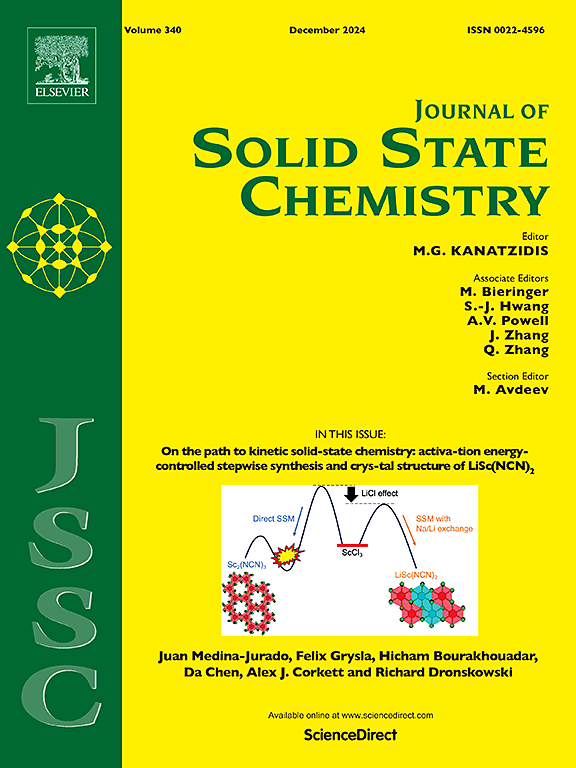氢键促进羟基对吡啶二羧酸镧框架光物理和催化特性的影响
IF 3.2
3区 化学
Q2 CHEMISTRY, INORGANIC & NUCLEAR
引用次数: 0
摘要
为了研究氢键相互作用对光物理性质和催化活性的影响,同时避免受到结构差异的干扰,我们合成并表征了两种新的等结构[LnIII2(OH-pda)(ox)2(H2O)4]∙4H2O配位聚合物(LnIII = EuIII (I) 和 NdIII (IIa),OH-H2pda = 4-羟基吡啶-2,6-二甲酸,H2ox = 草酸)。它们与含有 pda2- 而非 OH-pda2-的[NdIII2(pda)(ox)2(H2O)4]∙4H2O(IIb,H2pda = 吡啶-2,6-二羧酸)也是同种结构。IIa 和 IIb 的框架结构完全相同,但 IIa 中由于 OH-pda2- 的 -OH 基团而产生了额外的氢键相互作用。在 IIa 和 IIb 的基础上,研究了 -OH 基团对光物理性质和催化活性的影响。参考紫外-可见吸收光谱和磷光发射光谱,测定了 OH-H2pda (41,600 和 19,200 cm-1)、H2pda (48,200 和 23,300 cm-1)、OH-pda2- (IIa,41,400 和 22,500 cm-1)和 pda2-(IIb,47,100 和 23,300 cm-1)的单线态(S1)和三线态(T1)能量,从中揭示了 -OH 基团的影响。提出了 -OH 基团作为电子供体和氢键促进剂的重要作用。在四丁基溴化铵存在下,通过在常压下与环氧氯丙烷进行无溶剂 CO2 环加成反应,对 IIa 和 IIb 的催化活性进行了比较研究。意外发现 IIa 的性能(最高产率为 62(±2)%)不如 IIb(最高产率为 68(±2)%),并证明了催化位点大量参与氢键相互作用的缺点。此外,还探讨了催化剂的可重复使用性。本文章由计算机程序翻译,如有差异,请以英文原文为准。

Influences of hydrogen-bond promoting hydroxyl group on photophysical and catalytic properties of lanthanide pyridine dicarboxylate frameworks
To study the influences of hydrogen bonding interactions on photophysical properties and catalytic activities with insignificant interference from structural disparity, two new isostructural [LnIII2(OH-pda)(ox)2(H2O)4]∙4H2O coordination polymers (LnIII = EuIII (I) and NdIII (IIa), OH–H2pda = 4-hydroxypyridine-2,6-dicarboxylic acid, H2ox = oxalic acid) were synthesized and characterized. They are also isostructural to [NdIII2(pda)(ox)2(H2O)4]∙4H2O (IIb), H2pda = pyridine-2,6-dicarboxylic acid) containing pda2− instead of OH-pda2-. The identical framework structure of IIa and IIb with additional hydrogen bonding interactions in IIa due to –OH group of OH-pda2- has been presented. Based on IIa and IIb, the effects of the –OH group on photophysical properties and catalytic activities were then investigated without structural bias. With reference to the UV–vis absorption and phosphorescent emission spectroscopy, the singlet (S1) and triplet (T1) state energies of OH–H2pda (41,600 and 19,200 cm−1), H2pda (48,200 and 23,300 cm−1), OH-pda2- (IIa, 41,400 and 22,500 cm−1) and pda2− (IIb, 47,100 and 23,300 cm−1) were determined from which the influences of the –OH group have been revealed. Important roles of the –OH group as electron-donating group as well as hydrogen bond promoter have been proposed. Catalytic activities of IIa and IIb were comparatively examined using the solvent-free CO2 cycloaddition reaction at atmospheric pressure with epichlorohydrin in the presence of tetrabutylammonium bromide. The inferior performance of IIa (maximum yield of 62(±2)%) to IIb (maximum yield of 68(±2)%) was unexpectedly disclosed and the drawback of the substantial involvement of the catalytic sites in hydrogen bonding interactions has been demonstrated. Their reusability was additionally explored.
求助全文
通过发布文献求助,成功后即可免费获取论文全文。
去求助
来源期刊

Journal of Solid State Chemistry
化学-无机化学与核化学
CiteScore
6.00
自引率
9.10%
发文量
848
审稿时长
25 days
期刊介绍:
Covering major developments in the field of solid state chemistry and related areas such as ceramics and amorphous materials, the Journal of Solid State Chemistry features studies of chemical, structural, thermodynamic, electronic, magnetic, and optical properties and processes in solids.
 求助内容:
求助内容: 应助结果提醒方式:
应助结果提醒方式:


